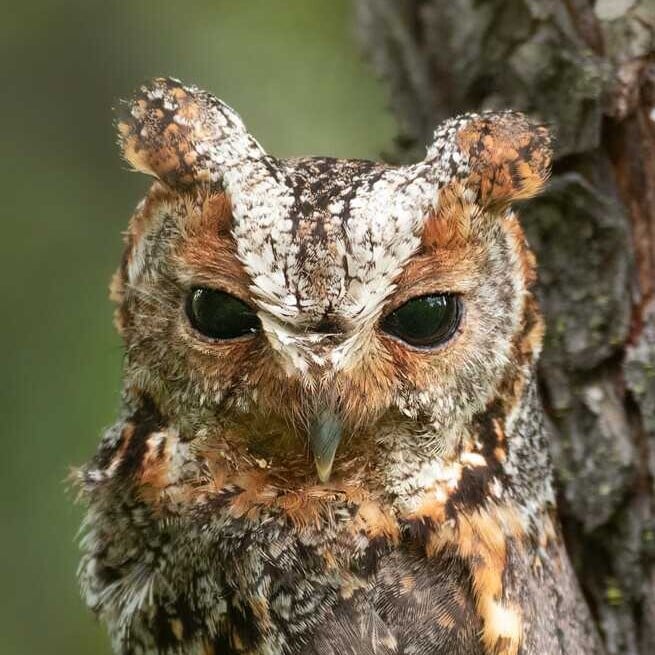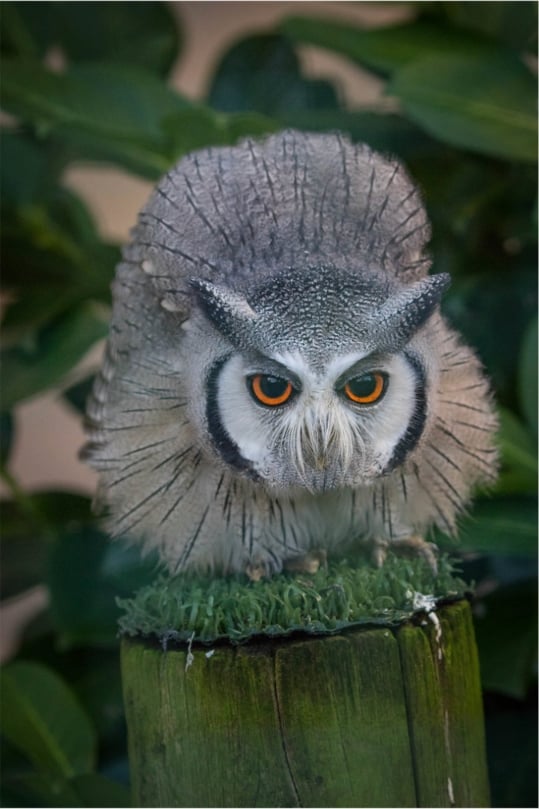Photo by Faruk Kizil
Habichtskauz auch Uralkauz
Das Bild entstand an einer Futterstelle beim Falkner in den Niederlande.
Ural owl (Strix uralensis)
The picture was taken at a feeding place of a falconer in Netherlands.
One of the given translations called this Habich’s Owl, so I tried to find out who Habich was. Took me way too long to figure out Habich was not a person, it means goshawk in German. The German wiki entry had a lot of info the US one didn’t though.
The species is referred to as Slaguggla, or “attacking owl”, in Swedish, Habichtskauz, or “goshawk-owl”, in German or as the “long-tailed owl” in Russian.
Attempts to re-introduce the owl have been partly successful in the German-Austrian-Czech border region (Bavarian Forest , Bohemian Forest , and Šumava), and most recently in the Vienna Woods.
Austria seems to have a difficult time with the project as people keep shooting them. 🙄


The german language has two words for “owl”: “Eule” and “Kauz”. I’m a native speaker, but I had to look up what the difference is (Wikipedia/Deepl):
“Eule” means “owl”.
“Kauz” also means owl, but specifically the small, fat and grumpy looking kind:
That’s literally it, it has nothing to do with biology. So the correct translation would be “grumpy-looking goshawk owl”. 😉
Wow, this is beautiful!
I’d heard eule before, but not kauz.
English only has one word, French has chouette and hibou, and Spanish has a lot of words, the main ones being buho (seems most common, and more specifically larger, horned owls), lechuza (barn owls), and the Mexican word tecolote (screech owl or possible pygmy owls, so seems more for small owls rather than horn/no horn). There’s a few more words I’ve seen, but most comments seemed to say if you use anything other than buho or lechuza, no one will know what you’re talking about.
The list of German owls does seem to split between eule and kauz right around the middle. I feel it’s a pretty good system!
As you were wondering about the translations: Schleiereule - “Veil Owl”
Zwergohreule - “Dwarf Ear Owl”
Schnee-Eule - “Snow Owl”
Sperber-Eule - “Sparrowhawk Owl”
Sperlingskauz - “Sparrow Owl”
Steinkauz - “Stone Owl”
Waldkauz - “Forest Owl”
Habichtskauz - “Goshawk Owl”
Waldohreule - “Forest Ear Owl”
Sumpfohreule - “Swamp Ear Owl”
Rauhfußkauz - “Scraggly Foot Owl”
Thank you so much! It’s so interesting to see the other names people have come up with for the same things.
Ones I like better: Zwergohreule Sperber-Euhle Both of these I think describe them better than the English names.
Ones I don’t get: Habichtskauz - I did not think it looked like the Goshawk. The Sperber-Euhle I liked because it looked more like a Sparrowhawk than the Red-Tailed Hawk, which is the default hawk for my brain.
Rauhfußkauz - The legs/feet look pretty typical to me.
Not sure if I like Steinkauz better than Little Owl. Little Owl sounds cute, but is hard to tell Little Owl vs a little owl, while stone owl is appropriate for size, but does not reflect they are cute, unless Germans have particularly cute rocks over there. 😄
According to German Wikipedia, the Rauhfußkauz has its name from its feathered feet. But it isn’t the only one, as e.g. the Snowy Owl also has this feature.
I would have named him over that big round head. Trying to look up any direct translation to German for “big-headed” all seem to translate to mean arrogant rather than a physical feature. The closest I found is another bird, Brauenbreitschnabel, which says it means “Broad Headed Beak” but I don’t think that looks to have a particularly large head, so I don’t know if that is correct either.
He German Wikipedia of the Habichtskauz says:
The name Steinkauz refers to the location they use for breeding, which are, beside tree hollows, barns, chapells and wine cellars built of stone.
That was my guess about Habichtskauz, but to me the standout feature of this particular owl is the face. From skimming the German wiki for it, even though it looks gentle, it seems very territorial and aggressive, so that may also factor into the hawk similarities, but I don’t have either bird where I am to make much comparrison.
Steinkauz makes better sense now, being named after where it is living. Reminds me of the Rock Eagle Owl.
Thank you for all your insights today! I have really learned a lot from all this!
Or the Barn Owl which commonly is found in barns.
I like Barn Owl a little less, along the line of the joke that always comes up of “what did they call them before barns were invented.” Plus Barn Owls are basically everywhere, not just relegated to places there are barns. Veiled Owl works in every occasion, though when I ran the translate feature on the German wiki for the Ural Owl, it seemed to translate the word it had for facial disc, so maybe that is a word that refers to too many owls in German. (Just checked, Gesichtsschleier is the word it was translating to “facial veil”)
Looking at the list again, it’s interesting Barn Owl is an euhle as it has a round head. Many other languages also seem to separate out the barn owl types. That seems to lend support to the “personality traits” explaination of the euhle/kauz differences.
See it the other way around: A barn isn’t a proper barn without accommodating a Barn Owl.
However, in German, some birds are called by their current habitat: Feldlerche (Eurasian Skylark), Feldsperling (Eurasian Tree Sparrow), Haussperling (House Sparrow), Hausrotschwanz (Black Redstart), Gartenrotschwanz (Common Redstart), … Yet, one may ask: Where did they live before there were fields, houses, and gardens?
Linguistic separation of the Barn Owls from the True Owls makes somewhat sense as they are the two separate families of the owls.
In the German Wikipedia article on owls Strigiformes I also found an explanation of the origin of the two terms Eule and Kauz:
Interestingly, the Eulen you are not supposed to carry to Athens (Eulen nach Athen tragen means doing something useless), are originally Steinkäuze (Athene Noctua) that were a symbol of the godess Athene and were depicted on the reverse side of the old Drachme coins from Athens.
Today, this Drachme coin is depicted on the reverse side of the Greek 1 Euro coin:
Thank you for the nice conversation.